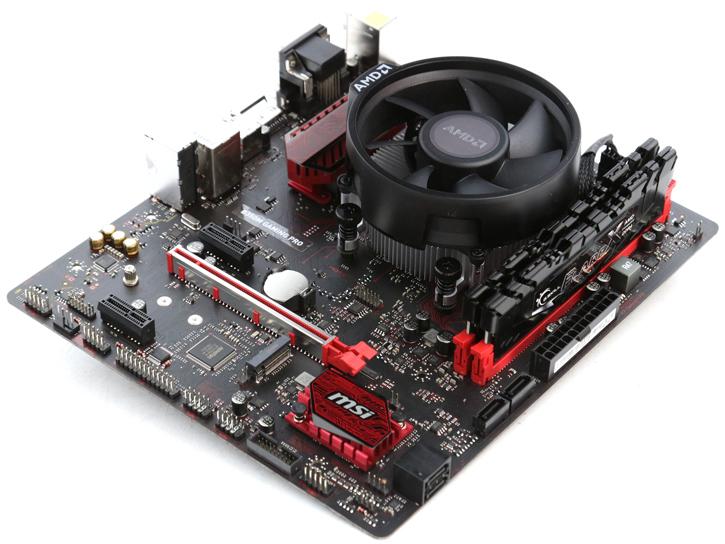The Greater Bit - The Less-Budget Build
The Greater Bit - The Less-Budget Build
We are now, for a site called Guru3D, in more familiar territory. Adding approximately 100-125 USD/GBP/EUR to the overall build budget can seriously affect what performance you can expect in the graphics space (not so much the CPU space). We are talking, roughly speaking, a near 2.5-3x increase in performance for around another 25% more money. In my mind (and any, I should hope) that's a pretty decent trade-off.
In terms of total spend here, you are looking at around 450-500 USD. Naturally, in an area which is not the United States, you might have to pay a little more, or perhaps temper your expectations by going with slightly lesser hardware (likely in the GPU space, or compromise on storage/case).
CPU: AMD Ryzen R3 2200G or Intel Pentium G5400a
Yep, he's back. Our friend, the 2200G, provides the 4 core/4 thread grunt needed to make this build live and work. Despite the potential requirements of modern AAA games sometimes really hammering quad-core CPUs that lack any kind of Hyperthreading/SMT, I feel like the 2200G is still the choice, here. A lower end GPU, like the ones you will see later, will almost certainly be the bottleneck in your system, working hard 100% of the time and leaving your CPU room to breathe. This isn't that surprising, given how graphically intensive modern gaming is. That said, if you just intend to play e-sports titles and older games, then both the CPU and GPU in this build will be fine. End of discussion there!
Depending on availability, you could (and I will say this with a fairly large handful of 'but wait') elect to go for the cheaper Intel Pentium G5400, which retails at around 75 USD. I would, however, caution on this. Whilst quad cores can have a bit of a torrid time in certain titles, dual cores with SMT/Hyperthreading can be truly dire. I would only go for this option if you either intended to upgrade to a true quad core soon or never had any intention whatsoever of playing anything that is heavy on the CPU. They certainly can do so, don't get me wrong, but dual cores like the 5400 (and even the recently released Athlon 200GE) will struggle. In my opinion, avoid, and go for the 2200G or even R3 1200 from Ryzen Generation 1, aka. Summit Ridge.
You'll also notice that I have not included a cooler with this build. The 2200G comes with a basic Wraith Stealth unit, and for gaming/general use, it's enough for a mild overclock on the CPU to around 3.8Ghz. More important for Ryzen, really, is your memory speeds.
Motherboard: MSI B350M Gaming Pro or Gigabyte AB350M DS3H
The MSI board returns here because I honestly think it is a steal at how cheaply it can be had at sub 60USD. I also felt that it's strong/friendly UEFI was a winner for new builders just getting used to having built and gotten their PC running. However, for this build (where money could potentially swing a higher end GPU or not), I have elected to also include Gigabyte's very entry level AB350M board. It's not fancy at all, but it'll get the job done for sure. If you intended this PC as a 'build and then forget' project, go for this. If, however, you ever intended to upgrade or slot a nicer/higher end Ryzen CPU in, I'd go for the MSI product.
If you elect to go for the Intel Pentium based build, you will simply need to pick the cheapest H310 motherboard you can find. It's as simple as that. They can technically support up to the highest end Coffee Lake 8700k, though will not be able to overclock it. The VRM should, also, be entirely able to handle a 95W stock frequency hex-core CPU.
RAM: 8GB DDR4, 2x 4GB @ 3000Mhz
In reality, I will simply recommend the same RAM kit found in the previous entry, for obvious reasons. It's cheap, fast, will attain the XMP profile with ease, and that's all you really need to do. For all you nerds out there (me, as well), you can eke extra performance out of your RAM by fine-tuning the timings, otherwise what some might more generally refer to as 'CAS' latency.
Storage: 128-256GB SSD
The same advice I gave in the previous and lesser iteration of this build applies here. There really isn't the budget overhead for a second storage drive, so that will likely be your priority for a first upgrade or addition. Given that most of the extra financial headroom in this build is going toward a GPU, it might still be that 128GB is all you can afford to get. However, given that you are already spending a bit more money, I don't think an extra $20 on an SSD that is double the capacity will be a problem? Therefore, try to get the bigger drive into this build. It will make your life so much easier, particularly in the few weeks post build where you don't yet have a hard drive.
GPU (Graphics Card): Nvidia GTX 1050Ti, or GTX 1050/AMD RX560
Thankfully, the price of GPUs began to decline earlier this year, so much so that we are seeing nearly two-year-old cards at their original MSRP... what a time to be alive, right? Anyway, this also means that the lower end of the GPU space has also somewhat returned to normal. For a time, the lower end cards were the only offerings even close to their original MSRP, and even then, they were somewhat inflated.
Depending on where you are in the world, the price of the GTX 1050Ti may or may not be justifiable in a budget build like this. They are commonly available for around $150 USD, which is the original MSRP for the card. At this level of performance, it is categorically not worth spending extra money on a 'flash' version of the card. Period. It's the same GPU107 graphics chip under the hood, and bar some fancy lights or extra fans, the extra $50 USD or so isn't worth the outlay. The 1050Ti is, in essence, the perfect budget graphics card. It can utterly monster e-sports titles such as Dota 2, LoL, Starcraft 2, Overwatch, Fortnite, and more. It is entirely capable of high quality, 1080p gaming in even more demanding titles. Only the heaviest of AAA games will force you to play on low or medium settings. That said, don't go into buying a 1050Ti thinking it is invulnerable. It is, still, a lower end card, and more demanding and modern (i.e. 2018 and beyond) titles are likely going to make it work very hard.
So, what about those other two cards I mentioned? Namely Nvidia's GTX 1050, and Radeon Group's RX 560. On paper, the 1050 has a slight edge, perhaps 5% or so. In reality, these cards are aimed at gaming in titles where 5% likely will not matter to the person using it. E-Sports titles are the target market here, and whilst these GPUs can take on more demanding AAA titles, please do not expect high frame rates or graphical settings. Older titles will, however, happily play on these cards, so much so that you might even be able to take advantage of DSR (Dynamic Super Resolution) to increase the in-game pixel count, whilst still maintaining 60fps. Naturally, this is a trick that all GPUs can do, but I always got a kick out of playing the original (and heavily modded) Skyrim on an 860M at 4k 30fps locked.
Power Supply... as you were before
Again, a PC of this caliber needs only to be fed with very little power, so the same power supply recommendations that I made before still apply here. Go for 550W if you are fairly (or almost) certain that a GPU upgrade is upcoming down the line. 450W could still handle even a GPU such as the GTX 1080 or RTX 2080 (I am serious), given the power efficiency of modern day graphics processors.
With that, we have the budget end of the spectrum out of the way. I think, in retrospect, both PCs offer excellent price vs. performance, all without the possibility of breaking whatever is in your bank account. Now, however, we will start to move up the performance scale, where you will see 'performance per dollar' rise really rather dramatically.


